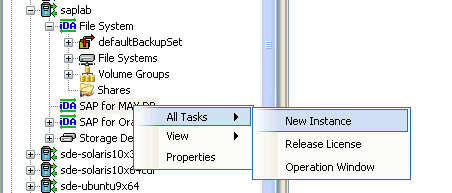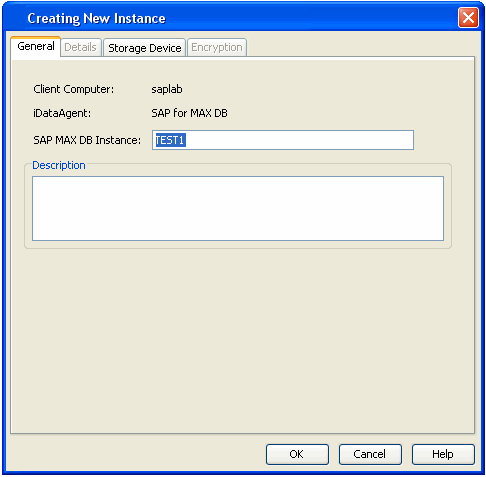dbmcli on CERT1>db_state
OK
State
ADMIN
- From the CommCell Browser, navigate to Client Computers |<Client> | SAP for MaxDB.
- Right-click SAP for MaxDB | All Tasks and Click New
Instance.

- Enter the Instance name in SAP MaxDB Instance text field
- Enter a description about the instance.

- Install the SAP Backint program.
- Create the media types and the backint configuration file.
- Configure backint
- Configuring backint on Unix.
Run each of the adjacent commands to configure backiint on Unix
/<software install path>/SapMaxDbAgent/backint.conf
dbm_configset -raw set_variable_0
LD_LIBRARY_PATH=/<software install path>/Base
dbm_configset -raw set_variable_1
SHLIB_PATH=/<software install path>/Base
Include the following lines in .profile for AIX and HP-UX:SHLIB_PATH=/<software install path>
/Base:/<software install path>/Base64
export SHLIB_PATH
Include the following lines in .profile for Linux and Solaris:
LD_LIBRARY_PATH=/<software install path>/Base:/<software install path>/Base64
export LD_LIBRARY_PATH
- Configuring backint on Windows.
Run the adjacent command to configure backint on Windows.
The software install path should be the same as the path provided during the SAP for MAXDB on Windows installation.
On Unix (All Platforms):
Include this information in the param file under <software_install_folder>/SapMaxDbAgent.
On Windows:
Include this information in the param file under the SAP MAXDB config file directory that you provide in the installation pop-up window during the installation.
srccrossclient
magnum.company.com
- Use Backint to restore the latest copy of these files manually.
- Get the full set of backup job IDs. Specifically, create an input file called file1.txt. Ensure that the contents of the file is #NULL, and run an inquiry to get a list of backups.
- Using the last job ID to get the catalog files, create an input file called file2.txt, and include the last job ID in the file (e.g., SAP_0_28). Then execute the following command:
- Restore the catalog files. Specifically, create an input file called file3.txt. Include contents similar to the following in the file:
Then execute the following command to restore the dbm.knl and dbm.ebf catalog files:
- If possible, enter the following dbmcli command: backup_ext_ids <medium_using_Backint> <original_database_name>.
- If possible, use the Restore without Backup History option in the DBMGUI recovery wizard provided by SAP.
For example:
backint -u -f inquire -t file
-p param -l file1.txt
backint -u -f inquire -t file
-p param -i file2.txt
SAP_0_28 d:\maxdb\sdb\data\wrk\CLDB\dbm.ebf
SAP_0_28 d:\maxdb\sdb\data\wrk\CLDB\dbm.knl
backup backint -u -f restore -t file
-p param -i inp3.txt
#> dbmcli -d CERT1 -u dbm,dbm -uUTL
dbmcli on CERT1>db_state
OK
State
ADMIN
# dbmcli -d CERT1 -u dbm,dbm -uUTL
dbmcli on CERT1>
backup_ext_ids_get BackData2
OK
dbmcli on CERT1>
backup_ext_ids_list
OK
END
dbmcli on CERT1>recover_start
BackData2 DATA ExternalBackupID "CERT1
dbmcli on CERT1>exitOK
dbmcli on CERT1>db_state
OK
State
ADMIN
# dbmcli -d CERT1 -u dbm,dbm -uUTL
dbmcli on CERT1>
backup_ext_ids_get BackData2
OK
dbmcli on CERT1>
backup_ext_ids_list
OK
END
dbmcli on CERT1>recover_start
BackLog LOG ExternalBackupID "CERT1
dbmcli on CERT1>recover_replace
BackLog ExternalBackupID "CERT1
dbmcli on CERT1>exit
OK